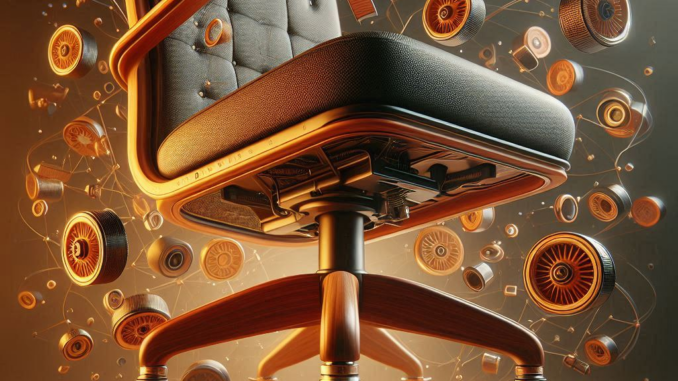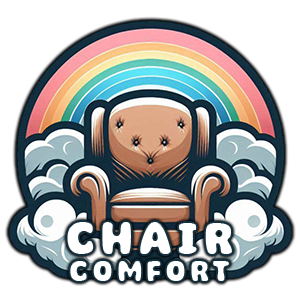
What Are Casters on a Chair?
Have you ever wondered about those little wheels on the bottom of your office chair? You know, the ones that let you zip around your workspace without getting up? Those are called casters, and they’re pretty cool little gadgets. In this post, we’re going to dive into everything you need to know about chair casters – from what they are to why they matter. So, buckle up (or should I say, roll up?) and let’s get started!
Quick Answer
Casters are small, wheeled devices attached to the legs of chairs and other furniture to allow easy movement across floors. They typically consist of a wheel and a mounting system that connects to the chair, enabling smooth rolling and enhancing mobility in various settings.
The Basics: What Exactly Are Chair Casters?
Alright, let’s break it down. Chair casters are those nifty little wheels you find on the bottom of many office chairs, rolling chairs, and even some home furniture. They’re like tiny skates for your chair, letting you move around without having to lift the whole thing up.
Here’s a fun little story: When I first started working from home, I had this old wooden chair that was comfy but a real pain to move. Every time I wanted to scoot over to grab something, it was like a workout! Then I got a chair with casters, and let me tell you, it was a game-changer. Suddenly, I was gliding around my home office like a pro figure skater (okay, maybe not that graceful, but you get the idea).
The Anatomy of a Caster
Now, let’s get a bit more technical (but not too much, I promise). A typical chair caster has a few main parts:
- Wheel: This is the part that actually rolls. It can be made of different materials, which we’ll talk about later.
- Housing: This is the part that holds the wheel and connects to the chair.
- Stem or Plate: This is how the caster attaches to the chair. Some casters have a stem that pops into a hole, while others have a plate that screws onto the bottom of the chair.
A Brief History of Chair Casters
Believe it or not, chair casters have been around for quite a while. The story goes that Charles Darwin, yes, that Charles Darwin, was the first person to put wheels on an office chair. Apparently, he wanted to scoot around his study faster to look at different specimens. Talk about evolving your workspace!
But it wasn’t until 1876 that someone actually patented chair casters. A guy named David A. Fisher thought, “Hey, these wheel things could really catch on,” and boom – chair casters became a thing.
Types of Chair Casters: Not All Wheels Are Created Equal

Just like how there are different types of cars for different needs, there are different types of casters too. Let’s roll through the main ones:
Rigid Casters: The Straight Shooters
Rigid casters are like that one friend who always goes straight to the point. They only move forward and backward in a straight line. You don’t see these on office chairs much, but they’re great for things like shopping carts where you want more control over the direction.
Swivel Casters: The Flexible Friends
These are the most common type you’ll find on office chairs. Swivel casters can turn in any direction, giving you the freedom to roll wherever you want. They’re like the social butterflies of the caster world – always ready to go with the flow.
Locking Casters: The Safety-First Squad
Locking casters are like swivel casters with a superpower. They can lock in place when you don’t want to move. These are great for when you need to stay put, like when you’re working on something that requires a steady hand.
The Great Debate: Hard vs. Soft Casters
Now, let’s talk about what these little wheels are made of. It’s not just a random choice – the material of your casters can make a big difference in how they perform and how they treat your floors.
Hard Casters: The Tough Guys
Hard casters are usually made of materials like plastic or metal. They’re the bodybuilders of the caster world – strong and durable. Here’s what you need to know about them:
- Best for: Carpeted floors
- Pros: Can handle heavy loads, last a long time
- Cons: Can be noisy and might damage hard floors over time
Soft Casters: The Gentle Giants
Soft casters are made from materials like rubber or soft plastic. They’re like the yoga instructors of casters – flexible and easy on the surfaces they touch. Here’s the lowdown:
- Best for: Hard floors like wood, tile, or linoleum
- Pros: Quiet, smooth operation, won’t scratch your floors
- Cons: May not last as long as hard casters, especially under heavy use
Choosing the Right Casters: It’s Not Rocket Science, But It’s Important
Picking the right casters for your chair isn’t just about looks (although, let’s be honest, a nice set of casters can really jazz up a chair). Here are some things to think about:
1. What’s Your Floor Like?
This is probably the biggest factor. Remember:
- Carpet = Hard casters
- Hard floors = Soft casters
2. How Heavy Are You (and Your Chair)?
No judgment here, but weight matters when it comes to casters. If you’re on the heavier side, or if your chair is built like a tank, you might want to go for casters with a higher weight capacity.
3. How Quiet Do You Need to Be?
If you work in a library or just don’t want to announce your every move, soft casters are generally quieter.
4. Do You Need to Stay Put Sometimes?
If you find yourself needing to lock your chair in place now and then, consider casters with a locking mechanism.
Maintaining Your Casters: Keep ‘Em Rolling
Just like how you need to take care of your car to keep it running smoothly, your chair casters need a little TLC too. Here are some tips to keep your casters in tip-top shape:
Regular Cleaning: No One Likes a Hairy Situation
Hair and dust can get wrapped around the wheels of your casters, making them harder to roll. Every so often, flip your chair over and clean out any gunk that’s collected. You can use a pair of tweezers or a butter knife to get in there and clear things out.
Lubrication: Keep Things Moving
If your casters are starting to squeak or aren’t rolling as smoothly, a little lubrication can go a long way. You can use a silicone-based lubricant or even a bit of WD-40. Just be careful not to overdo it – you don’t want a slippery mess on your floors!
Check for Wear and Tear
Over time, casters can wear down or even break. Every few months, take a look at your casters and see if they’re looking worse for wear. If you notice any cracks, chips, or if the wheel seems wobbly, it might be time for a replacement.
The Benefits of Good Casters: More Than Just Rolling Around
Now, you might be thinking, “They’re just wheels, right? What’s the big deal?” But good casters can make a real difference in your day-to-day life. Here’s how:
1. Ergonomics: Your Body Will Thank You
Being able to move easily in your chair means you’re more likely to adjust your position throughout the day. This can help prevent strain and discomfort from sitting in one position for too long.
2. Productivity: Roll Your Way to Success
Need to grab something from across the room? With good casters, you can just roll over instead of getting up. It might not seem like much, but those little time savers can add up over a day.
3. Floor Protection: Save Your Surfaces
The right casters (remember, soft for hard floors!) can help protect your floors from scratches and damage. Your future self (or your landlord) will thank you.
4. Versatility: Be Ready for Anything
Good casters let you easily rearrange your space. Need to make room for a impromptu dance party in your office? Just roll those chairs out of the way!
The Future of Casters: What’s Rolling Our Way?
Believe it or not, there’s actually some pretty cool innovation happening in the world of casters. Here are a few trends to keep an eye on:
Smart Casters
Imagine casters that could track how much you move during the day, or that automatically lock when you stand up. Some companies are working on “smart” casters that can do just that.
Eco-Friendly Materials
As we all become more environmentally conscious, some manufacturers are exploring more sustainable materials for casters, like recycled plastics or biodegradable components.
Customizable Casters
Why settle for boring black wheels when you could have casters that match your office decor? Customizable casters are becoming more popular, letting you add a little personality to your chair.
Wrapping It Up: The Bottom Line on Bottom Wheels
So there you have it – probably more than you ever thought you’d know about chair casters! From their history to their future, these little wheels play a bigger role in our daily lives than we often realize.
Next time you’re scooting around your office or rolling over to grab a snack, take a moment to appreciate those hardworking casters. And remember, choosing the right casters and taking care of them can make a big difference in your comfort, productivity, and even the lifespan of your floors.
Now, I don’t know about you, but all this talk about rolling around has me feeling a bit dizzy. I think I’ll take my caster-equipped chair for a spin around the office to celebrate. Happy rolling, everyone!
FAQs: Your Burning Caster Questions, Answered
Can you take casters off a chair?
Yep, most casters can be removed. It’s usually as simple as pulling them out of their sockets, though some might need a bit more elbow grease. If you’re not sure, check your chair’s manual or look up a video for your specific model.
Why is it called a caster?
The word “caster” comes from “cast,” which means to throw or pour in a mold. Early casters were made by pouring molten metal into molds, hence the name. It’s stuck around even though we make them differently now.
Are chair casters universal?
Not always. While many casters are designed to fit a standard size, there can be differences in stem size, shape, and how they attach. It’s always best to check your chair’s specifications before buying new casters.
How often should I replace my chair casters?
It depends on how much you use your chair and what kind of surface you’re rolling on. As a general rule, if your casters are squeaking, not rolling smoothly, or showing visible wear and tear, it’s probably time for new ones.
Can I use my office chair on carpet without damaging it?
Yes, but you’ll want to use hard casters. Soft casters can get bogged down in carpet fibers. If you’re worried about damaging the carpet, you can also get a chair mat to roll on.
Got more questions? Don’t be afraid to reach out to a furniture specialist or the manufacturer of your chair. After all, when it comes to comfort and productivity, every little detail counts – even the wheels on your chair!


Leave a Reply